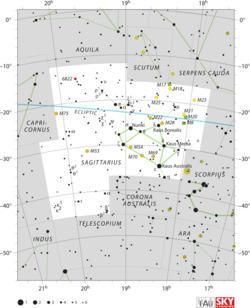Astronomy:Psi Sagittarii
| Observation data Equinox J2000.0]] (ICRS) | |
|---|---|
| Constellation | Sagittarius |
| Right ascension | 19h 15m 32.42658s[1] |
| Declination | −25° 15′ 24.0569″[1] |
| Apparent magnitude (V) | +4.86[2] |
| Characteristics | |
| Spectral type | K2 III + A9 III + A3 V[3] |
| B−V color index | 0.569±0.006[2] |
| Astrometry | |
| Radial velocity (Rv) | −11.43±1.47[4] km/s |
| Proper motion (μ) | RA: +45.50[1] mas/yr Dec.: −31.08[1] mas/yr |
| Parallax (π) | 10.93 ± 0.31[1] mas |
| Distance | 298 ± 8 ly (91 ± 3 pc) |
| Absolute magnitude (MV) | 0.06[2] |
| Orbit[5] | |
| Period (P) | 7,319 d |
| Eccentricity (e) | 0.51 |
| Periastron epoch (T) | 2442418.795 JD |
| Argument of periastron (ω) (secondary) | 2.6° |
| Semi-amplitude (K1) (primary) | 10.0 km/s |
| Semi-amplitude (K2) (secondary) | 13.8 km/s |
| Details | |
| A | |
| Mass | 2.10[6] M☉ |
| Luminosity | 84[2] L☉ |
| Ba/Bb | |
| Mass | 1.70/2.70 M☉ |
| Other designations | |
| Database references | |
| SIMBAD | data |
Psi Sagittarii, which is Latinized from ψ Sagittarii, is a triple star[8] system in the zodiac constellation of Sagittarius. The star system is located at a distance of 298 light years from the Earth based on parallax, but is drifting closer with a heliocentric radial velocity of −12 km/s.[4] The system is faintly visible to the naked eye has a combined apparent visual magnitude of +4.86.[2]
The inner pair of this triple star system, components Ba and Bb, have an orbital period of 10.78 days and an eccentricity of 0.47.[8] The pair consist of an A-type giant and a less evolved A-type main-sequence star with stellar classifications of A9 III + A3 V,[3] respectively. These in turn share an orbit with the primary, component A, having a period of 20 years and an eccentricity of 0.51.[5] The last is an orange-hued K-type giant with a class of K2 III.[3]
Name and etymology
According to the catalogue of stars in the Technical Memorandum 33-507 - A Reduced Star Catalog Containing 537 Named Stars, this star was titled as Al Kiladah.[9] This star, together with τ Sgr, ν Sgr, ω Sgr, 60 Sgr and ζ Sgr were Al Udḥiyy, the Ostrich's Nest.[10]
References
- ↑ 1.0 1.1 1.2 1.3 1.4 van Leeuwen, F. (2007), "Validation of the new Hipparcos reduction", Astronomy and Astrophysics 474 (2): 653–664, doi:10.1051/0004-6361:20078357, Bibcode: 2007A&A...474..653V.
- ↑ 2.0 2.1 2.2 2.3 2.4 Anderson, E.; Francis, Ch. (2012), "XHIP: An extended hipparcos compilation", Astronomy Letters 38 (5): 331, doi:10.1134/S1063773712050015, Bibcode: 2012AstL...38..331A.
- ↑ 3.0 3.1 3.2 Docobo, José A.; Andrade, Manuel (November 2006), "A Methodology for the Description of Multiple Stellar Systems with Spectroscopic Subcomponents", The Astrophysical Journal 652 (1): 681–695, doi:10.1086/508053, Bibcode: 2006ApJ...652..681D.
- ↑ 4.0 4.1 Brown, A. G. A. (August 2018). "Gaia Data Release 2: Summary of the contents and survey properties". Astronomy & Astrophysics 616: A1. doi:10.1051/0004-6361/201833051. Bibcode: 2018A&A...616A...1G. Gaia DR2 record for this source at VizieR.
- ↑ 5.0 5.1 Pourbaix, D.; Tokovinin, A. A.; Batten, A. H.; Fekel, F. C.; Hartkopf, W. I. et al. (2004), "SB9: The ninth catalogue of spectroscopic binary orbits", Astronomy & Astrophysics 424 (2): 727–732, doi:10.1051/0004-6361:20041213, Bibcode: 2004A&A...424..727P.
- ↑ Tokovinin, A. (September 2008), "Comparative statistics and origin of triple and quadruple stars", Monthly Notices of the Royal Astronomical Society 389 (2): 925–938, doi:10.1111/j.1365-2966.2008.13613.x, Bibcode: 2008MNRAS.389..925T.
- ↑ "psi Sgr". SIMBAD. Centre de données astronomiques de Strasbourg. http://simbad.u-strasbg.fr/simbad/sim-basic?Ident=psi+Sgr.
- ↑ 8.0 8.1 Eggleton, P. P.; Tokovinin, A. A. (September 2008), "A catalogue of multiplicity among bright stellar systems", Monthly Notices of the Royal Astronomical Society 389 (2): 869–879, doi:10.1111/j.1365-2966.2008.13596.x, Bibcode: 2008MNRAS.389..869E.
- ↑ Rhoads, Jack W. (November 15, 1971), Technical Memorandum 33-507-A Reduced Star Catalog Containing 537 Named Stars, California Institute of Technology: Jet Propulsion Laboratory, https://ntrs.nasa.gov/archive/nasa/casi.ntrs.nasa.gov/19720005197_1972005197.pdf, retrieved 2017-07-02.
- ↑ Allen, R. H. (1963). Star Names: Their Lore and Meaning (Reprint ed.). New York: Dover Publications Inc. p. 355. ISBN 0-486-21079-0. https://archive.org/details/starnamestheirlo00alle/page/355. Retrieved 2012-09-04.
External links
- Kaler, James B. (November 4, 2016), "Psi Sagittarii", STARS, http://stars.astro.illinois.edu/sow/psisgr.html.
 |


